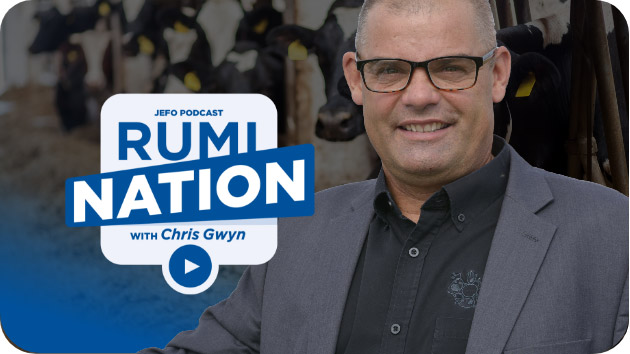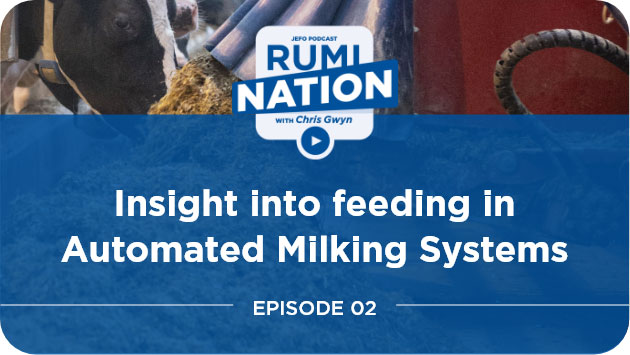RumiNation Podcast – Episode 01
Digging Deeper into Fatty Acid Nutrition – Palmitic Acid
Brought to you by Jefo Nutrition
Share now!
Did you enjoy this episode?
Share now!
Digging Deeper Into Fatty Acid Nutrition – Palmitic Acid
How do the dairy cow nutrition and milk production work? How can the cow transform unsaturated fatty acids into saturated fatty acids? What does palmitic acid feeding do to the cow on her production efficiency and on the milk itself?
Get answers and learn more about fatty acids, digestion and dairy nutrition with Dr. Adam Lock.
Our guest - Dr. Adam Lock
Research area
- Fatty acid digestion and metabolism of the dairy cow, including the impact on milk production and milk fat content.

Contact
Join the Rumination community
Timestamps & Summary
01:10:00 – What first got you into your area of research?
Dr. Lock was born and raised on a small dairy farm in England. He ended up doing a PhD in dairy nutrition that happened to be in the world of conjugated linoleic acid. Then his interest has pivoted from milk fat depression to bioactive fatty acids.
02:04:00 – Take me on a short tour on fatty acids, digestion and metabolism in dairy cows, when we feed a cow and how that moves through the cow system to the creation of milk fat
Dr. Lock explains that nearly every dietary ingredient a dairy cow eats has some degree of fatty acids or fat in it (like higher fat and lower fat in human food). But the rumen is a huge fermentation machine with a detoxification mechanism called biohydrogenation that basically transforms about 75% to 95% of the unsaturated fatty acids she consumes into saturated fatty acids.
He says that most people forget that typically, the dairy cow that has the fattiest diet is the one in very fresh pasture. If someone would go on and say that we should not feed fat to ruminants and that they aren’t designed to eat it, he would remind them that even if we formulate a diet that has around 4% of fatty acids in it, it will probably not be as high as if we put the cow in a fresh pasture.
08:02:00 – What does palmitic fatty acid feeding do to cows both on her production efficiency and the milk itself?
Dr. Lock says that milk fat is probably the most diverse liquid metric you find in nature. And palmitic acid feeding, not to be confused with palm oil, has a very unique role in dairy cow nutrition. Studies show that when you provide more palmitic acids to the diet, the cow will make more milk fat because of the synthesis of fat in the mammary glands. Also, palmitic acids improve fibre digestion in the rumen and it gets more energy from the forages that we feed.
We utilized high fat supplements for the past 40 years, they are not new. But we can now target specific fatty acids a lot better and provide what the cow can better utilize and best need. Just like we now understand the benefits of omega-3 and omega-6 for humans.
14:55:00 – What would be your take-home message about fatty acid feeding and ruminant diet for the audience?
For him, a big take-home is that the cow always has to produce a liquid milk fat at body temperature. In the kitchen, that butter doesn’t have a melting point, it has a melting range because of these different fatty acids (we know that our butter in the kitchen isn’t as soft in February then it is in July, because of the room temperature).
Regarding the buttergate issue in Canada, Dr. Lock hasn’t seen any data to support this room temperature shift in butter and he doesn’t think it can be attributed to palmitic acids alone. A lot more research around dairy cow management and product quality is required and we need to understand that better. Because there are just so many things that come into play when it comes to dairy nutrition.
Need more information?








